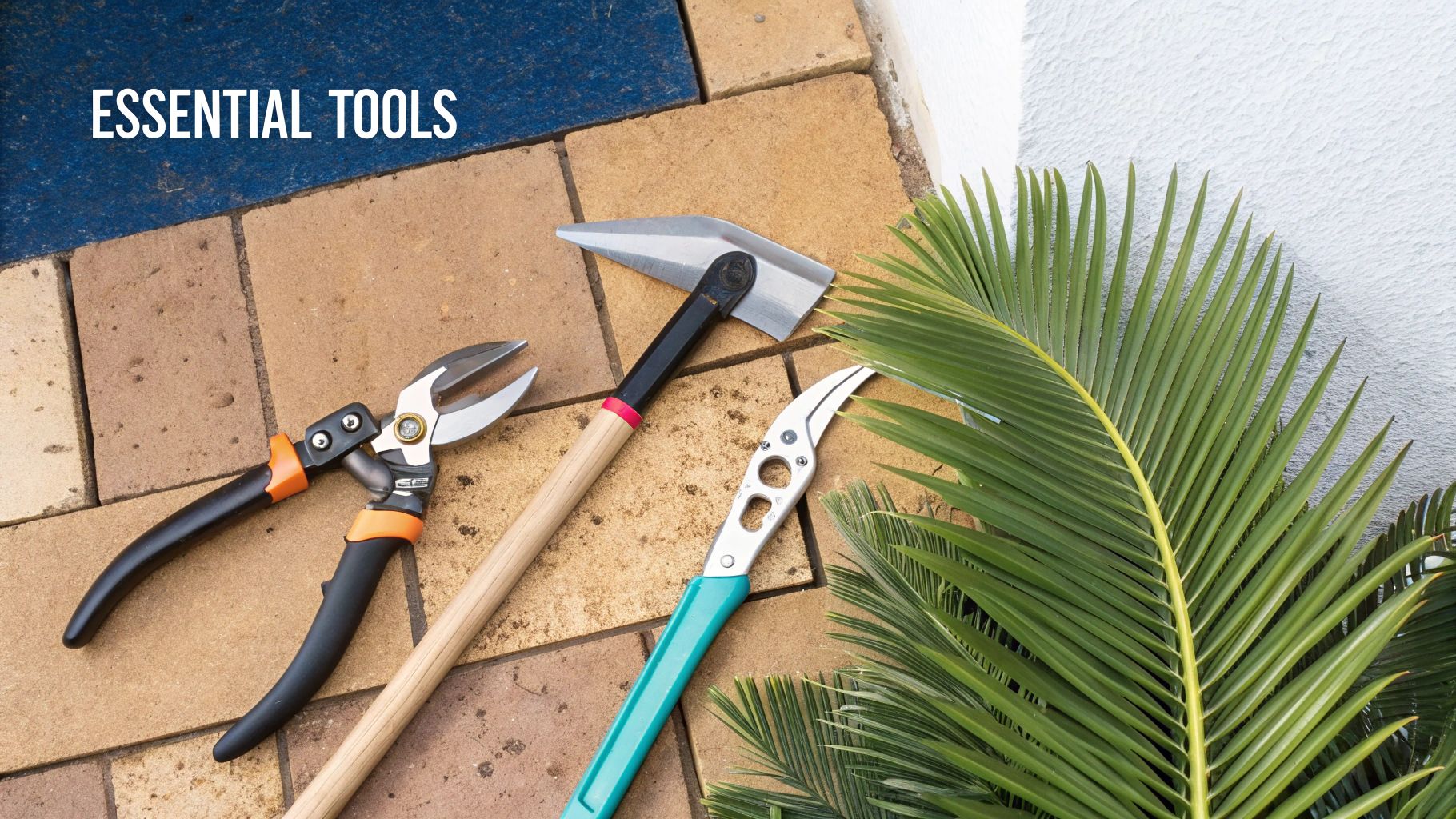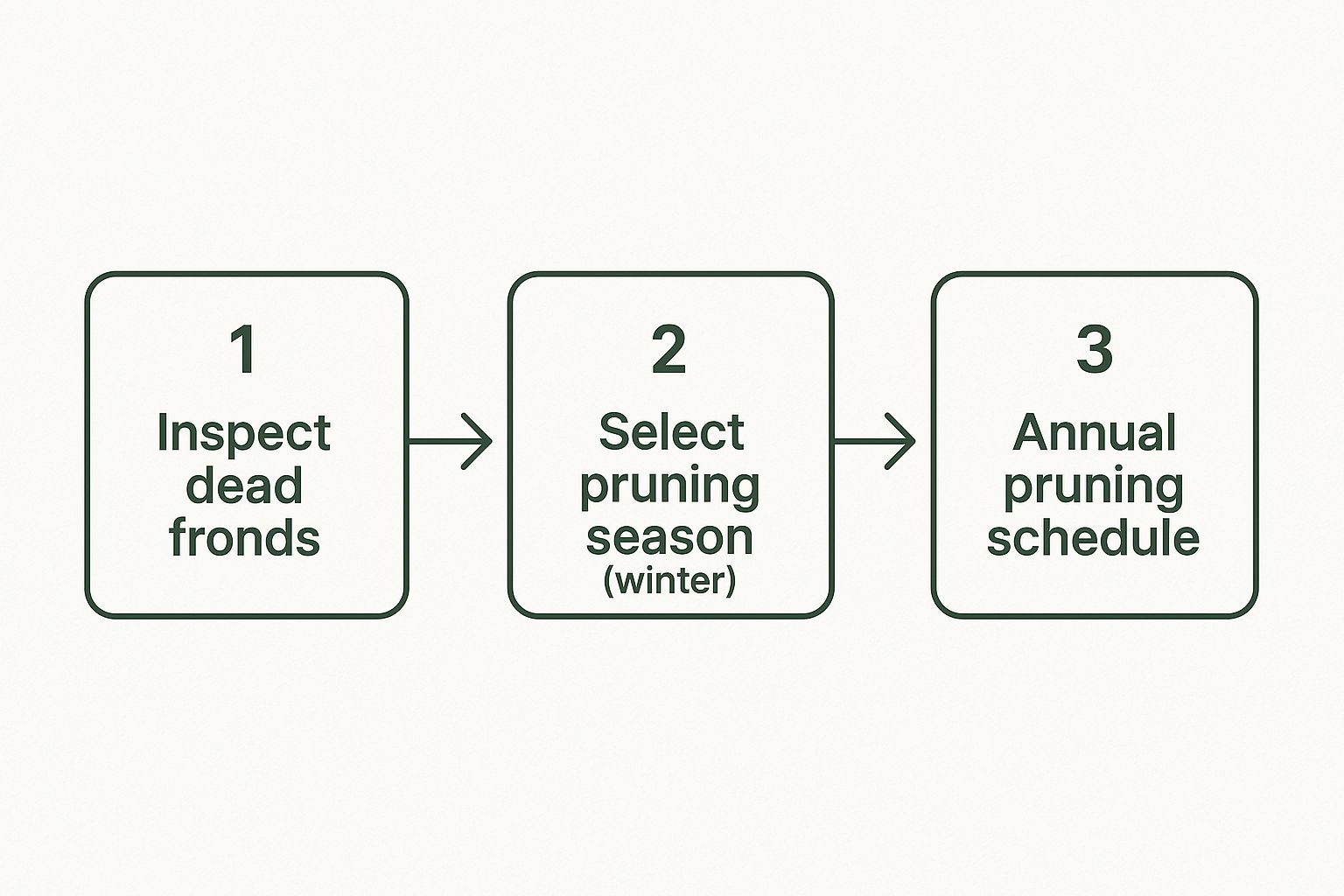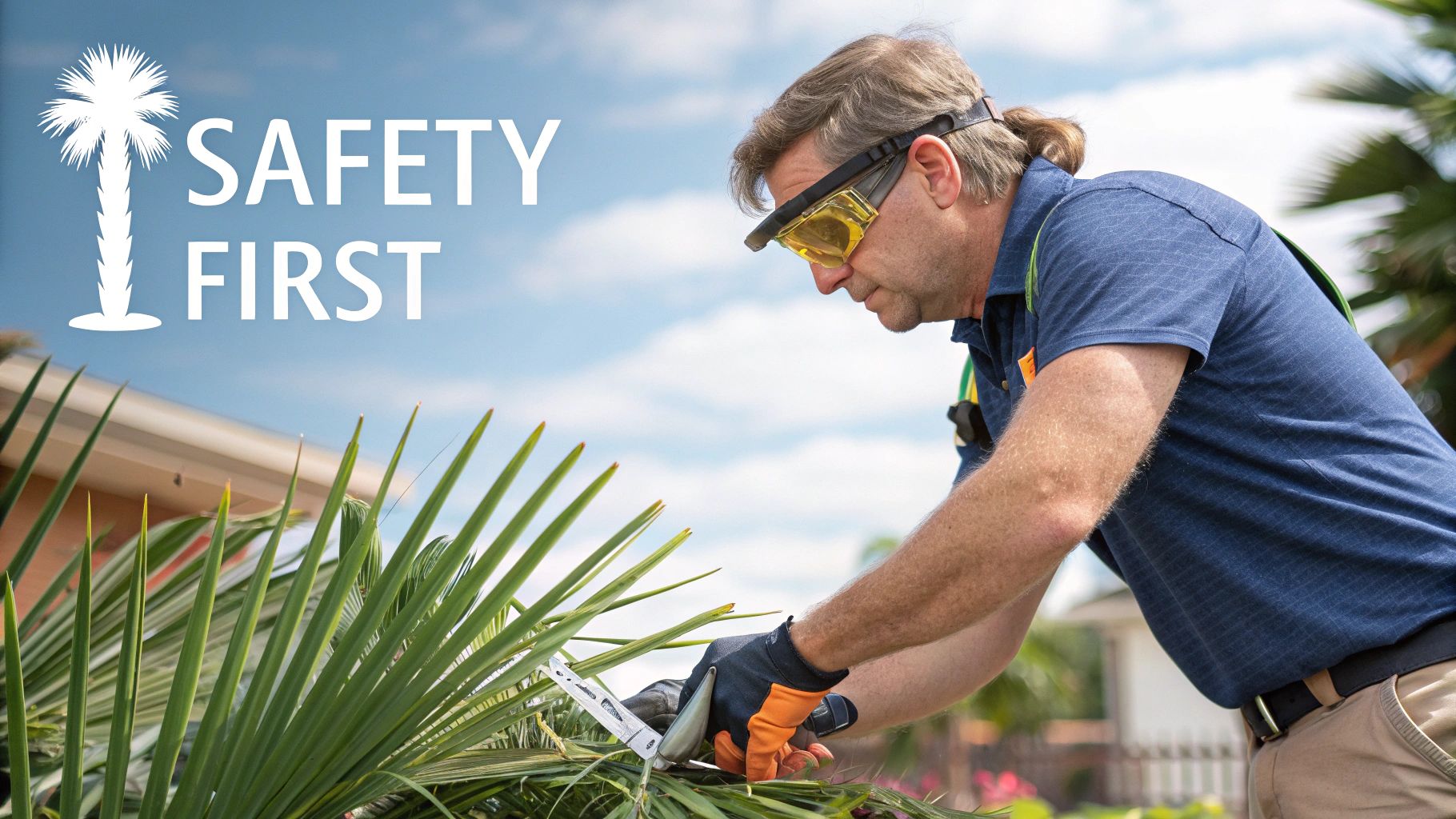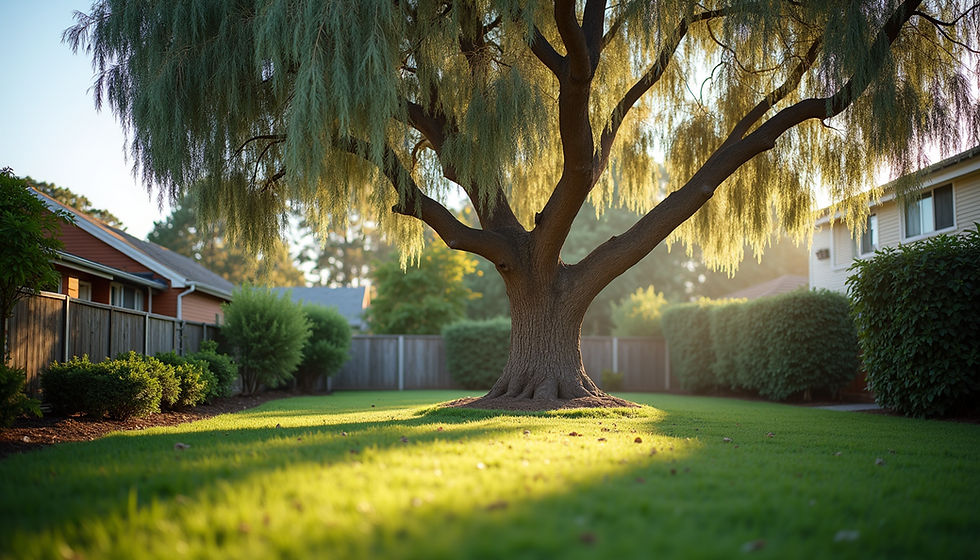How to Prune Palm Trees: A Perth Guide
- Swift Trees Perth

- Oct 6
- 14 min read
Pruning a palm tree is about more than just a quick tidy-up; it’s a vital part of keeping it healthy, safe, and looking its best. The real goal is to remove only what’s necessary—the dead, dying, or hazardous fronds—so the tree can put its energy into new growth instead of wasting it on failing parts.
Get this right, and you’ll avoid the common pruning mistakes that can cause long-term, sometimes irreversible, damage to your palms, ensuring they remain a stunning, resort-style feature of your garden.
Why Proper Palm Pruning Matters
Knowing how to prune a palm tree correctly is one of the most impactful things you can do for your landscape. It's a delicate balance between the tree's natural cycle and the safety and aesthetic needs of your garden. When you do it properly, it’s a health boost for the tree. Do it wrong, and you can cause serious harm.
Most people reach for the pruning saw to get rid of those brown, drooping fronds that spoil that clean, tropical vibe. But the benefits go much deeper than just appearances.
More Than Just Good Looks
Strategic pruning is about much more than curb appeal. It has a direct effect on the tree's long-term health and the safety of your property.
Pest and Disease Prevention: Those dead, decaying fronds are an open invitation for pests like rats and insects. They also create the perfect damp environment for fungal growth to take hold. For example, a thick skirt of dead fronds on a Cotton Palm is a notorious hiding spot for rodents in suburban Perth. Clearing them out removes potential breeding grounds.
Enhanced Safety and Fire Mitigation: During Perth's wilder weather, loose, dead fronds can become dangerous projectiles in strong winds. They also act as tinder-dry fuel, seriously increasing fire risk during our hot, dry summers.
Improved Tree Health and Vigour: By cutting away dead fronds and old fruit stalks, you’re helping the palm redirect its nutrients and energy towards producing strong, healthy new growth. This is particularly important for fruiting palms, as it encourages a better, healthier yield next season.
Debunking Common Pruning Myths
One of the worst things you can do to a palm is the severe "hurricane cut" or "pencil-topping." This is where almost all fronds are stripped away, leaving just a few sticking straight up. This practice is incredibly damaging and, frankly, out of fashion for modern garden aesthetics.
This kind of aggressive cutting essentially starves the palm by removing its ability to photosynthesise. It also weakens the tree's structure and leaves the sensitive new growth bud exposed to sun damage and pests.
A healthy, properly pruned palm should have a full, rounded canopy. A good rule of thumb is to never remove fronds that are growing above a horizontal line (think of the 9 and 3 o'clock positions on a clock face). Green fronds are the tree's engine room—cutting them off is like cutting its lifeline.
Here in Australia, the climate also guides our pruning schedule. Most experts suggest pruning palms in spring or early summer, usually between September and December. This timing lines up with the palm's active growing season, helping it to recover faster.
Interestingly, leaving some of the dead fronds on over winter can actually provide a bit of natural insulation against cold snaps and sunburn. You can find more insights into the best pruning practices for Australian palms at Northern Tree Services.
Ultimately, understanding the ‘why’ behind proper pruning is the first step. It ensures your palms will continue to be a stunning and healthy feature of your garden for many years.
If you're ever unsure about the health of your palms or you're facing a particularly tricky pruning job, getting professional advice is always the smartest move. For specialised palm tree maintenance in the Perth area, contact the experienced team at Swift Trees Perth for a free quote.
Choosing the Right Tools for the Job

Knowing how to properly prune a palm tree is only half the battle; you also need the right gear. Using the correct tool doesn't just make the job quicker and cleaner—it's vital for your safety and the tree's health. Trust me, hacking away with a blunt or unsuitable tool can tear at the trunk, leaving nasty, jagged wounds that are an open invitation for pests and diseases.
For smaller, more accessible palms, you often don't need much. A sharp pair of loppers or a sturdy, serrated pruning knife will usually do the trick for removing dead fronds cleanly. A little tip I've picked up from professional gardeners is the surprising effectiveness of a simple linoleum knife. It’s perfect for slicing through those tough, fibrous frond bases with minimal effort.
Gearing Up for Taller Palms
Once you're dealing with taller trees where the fronds are well out of reach, your toolkit needs an upgrade. This is where a pole saw becomes your best mate, letting you get the job done while keeping your feet safely on the ground.
Manual Pole Saws: These are lightweight and give you excellent, precise control over each cut. They're ideal for trees that aren't ridiculously high and just need some careful, selective trimming.
Powered Pole Saws: For thicker fronds or a much bigger job, an electric or petrol-powered pole saw gives you that extra cutting muscle. They are heavier, but they can seriously reduce the physical strain.
Whatever you choose, make absolutely sure the blade is sharp. A dull blade will crush and tear the fibres instead of slicing through them, which stresses the palm and leaves a messy finish that can compromise the tree’s health. Different species, like the robust Canary Island Date Palm found across Perth, might demand sturdier tools because of their dense growth.
The single most important rule when working on tall palms is to never use a ladder. An unstable ladder, combined with the awkward angles needed for pruning, is a recipe for a serious accident. Always stay firmly on the ground.
Essential Palm Pruning Tool Kit
To help you figure out what you need, here’s a quick breakdown of the essential tools based on the size of your palm and what you’re trying to achieve.
Having the right tool for the specific task not only improves the result but makes the whole process safer and more efficient.
Essential Safety Equipment
Your pruning tools are only one piece of the puzzle; personal protective equipment (PPE) is completely non-negotiable. Palm fronds can have surprisingly sharp edges and spines that can give you some nasty cuts.
Your essential safety kit should include:
Heavy-Duty Gloves: To protect your hands from sharp fronds and splinters.
Safety Glasses: To shield your eyes from falling dust, debris, and the odd insect.
Sturdy, Closed-Toe Footwear: To protect your feet from falling branches.
Being properly geared up prevents injuries and lets you focus on the task at hand. If the height of your palm or the tools required feel a bit out of your comfort zone, it's always safer to call in a professional.
The Pruning Process From Assessment to Cleanup
Right, you’ve got your tools ready, so it’s time to get stuck in. The key to pruning a palm isn't about brute force; it’s about making careful, precise cuts. A bit of thought beforehand ensures you only take off what’s necessary, which keeps your palm healthy and looking sharp.
First things first, you need to give the tree a proper look-over. Before you even think about cutting, walk around the palm and really assess it. Your mission is to spot which fronds need to go and, just as importantly, which ones need to stay put.
Identifying What to Remove
You're searching for clear visual signs that a frond is past its use-by date. These are the only ones you should be targeting.
Completely Brown and Dry Fronds: These are the most obvious ones. They're dead, brittle, and often just hanging limply against the trunk.
Yellowing Fronds: A frond that's mostly yellow is on its way out and can be removed. But if it's only got a hint of yellow, it might still be sending some nutrients back to the tree, so use your best judgment.
Broken or Damaged Fronds: Any fronds that have snapped or are badly bent, maybe after one of Perth's classic storms, should be taken off. This stops them from tearing the trunk on their way down.
This handy infographic gives you a simple rundown of the inspection and timing process for your yearly prune.

It’s a great visual reminder to check what the tree needs before you decide when to start cutting.
Now, this is crucial: leave the green fronds alone. They’re the palm’s engine room, handling all the photosynthesis and creating the energy it needs to thrive. Cutting them off essentially starves the tree and can cause a slow, sad decline.
Mastering the Correct Cutting Technique
Once you’ve picked a frond for removal, the actual cut is pretty straightforward. You want to get in close to the trunk, but not so close that you end up wounding it.
Leaving a small stub, or 'boot', of about 5-10 cm is a common and practical method many arborists prefer. It looks tidy and prevents scarring the main trunk, which could otherwise create an open invitation for pests and diseases. On a dense tree like a Canary Island Date Palm, this creates that classic, diamond-patterned trunk. On the other hand, self-cleaning species like the Bangalow Palm often drop their fronds naturally, so they need far less help from you.
A clean cut is a healthy cut. Don't tear or rip the frond away—this leaves a big, messy wound that heals poorly and looks terrible. Use a sharp saw and let the tool do the heavy lifting.
Dealing with Fruit and Flower Stalks
While you're sizing up the tree, have a look for any fruit or flower stalks. They're a normal part of a palm's life, but removing them can be a good move. It helps the tree redirect its energy from making seeds back into growing strong, healthy fronds.
There’s a practical upside for you, too—no more messy, dropped fruit staining your driveway or attracting unwanted visitors like bats and insects. These stalks can be cut right back, flush against the trunk.
The Final and Crucial Cleanup
Your job isn't done when the last frond hits the ground. A thorough cleanup is non-negotiable, especially for pest prevention. Piles of dead palm fronds are the perfect five-star resort for rats, snakes, and scorpions.
Rake up all the debris, right down to the small bits of bark and fallen fruit. Depending on how much you have, you can chop it up for your green waste bin or call in a proper disposal service. A clean and tidy garden is the finishing touch on a professional-quality prune.
If the height of your palm, the scale of the job, or the thought of the cleanup feels a bit much, don't be afraid to call in the professionals. For expert palm tree maintenance that handles everything from the initial assessment to a spotless cleanup, contact Swift Trees Perth for a free, no-obligation quote.
Common Pruning Mistakes to Avoid

Knowing how to prune a palm tree is just as much about knowing what not to do. It’s easy to make a few common mistakes that can seriously harm your palm, turning a simple maintenance task into a long-term problem for the tree.
These errors usually come from a misunderstanding of how palms work. They aren't like other trees, and treating them the same way can lead to some pretty ugly and unhealthy results. Avoiding these traps is the key to keeping your palm healthy and strong for years to come.
The Damage of Over-Pruning
One of the most widespread and damaging mistakes is over-pruning. You might have heard it called ‘pencil-topping’ or a ‘hurricane cut’. This is when far too many fronds are stripped away, leaving only a small, spiky tuft at the very top. While some people might think this looks neat and tidy, it’s actually starving the tree.
A palm’s green fronds are its engine room, its solar panels creating food through photosynthesis. When you remove too many, you’re crippling its ability to feed itself. This puts the palm under severe stress, making it far more vulnerable to pests and diseases.
You've probably seen a row of council palms pruned this way before a storm. The idea is to make them more wind-resistant, but the reality is often the opposite; a weakened palm with an exposed growth bud is more likely to snap.
Do this instead: A good rule of thumb is to never remove fronds growing above the horizontal plane (think of the 9 and 3 o'clock positions on a clock face). A healthy palm should have a full, rounded canopy of at least 180 degrees, ensuring it has plenty of green fronds to produce the energy it needs to thrive.
Never Use Climbing Spikes
Another critical mistake is using climbing spikes or gaffs to scale the trunk. While it might seem like a quick way to get up a tall palm, every single puncture from a spike creates a deep, permanent wound.
Unlike other trees, palms can't heal over these wounds by growing new bark. Each hole stays there forever, creating a perfect entry point for rot, fungi, and boring insects that can slowly kill the tree from the inside out. This kind of damage is irreversible. Many of these issues are common across all kinds of tree work, which is why understanding the risks of DIY tree care mistakes is so important for homeowners.
Pruning in the Wrong Season
Timing is everything. Pruning a palm during its dormant season, usually in the cooler autumn and winter months, exposes it to unnecessary stress. The tree is trying to conserve energy, and forcing it to heal from pruning can weaken it right before its next growing season.
Avoid Pruning: During autumn and winter when the palm's growth is slow.
Ideal Pruning Time: Late spring or early summer, when the tree is actively growing and can recover quickly.
If you’ve accidentally made a mistake or your palm is looking stressed, don’t panic. But if the job seems too big, too high, or you’re worried about causing permanent damage, calling in a professional is always the safest bet. For expert tree maintenance in Perth that puts the health of your palms first, contact Swift Trees Perth for an obligation-free quote.
When to Call a Professional Arborist

Learning to prune your own palm trees is a great skill to have, but there are definitely times when a DIY job is just too risky. Knowing your limits is key, both for your own safety and for the health of your palm. Some jobs simply demand the skills and specialised equipment that only a certified arborist brings to the table.
Stepping back and picking up the phone is the smartest move a property owner can make. The stakes are often too high to risk a fall or cause irreversible damage to a beautiful, valuable tree.
Key Signs You Need an Expert
If any of the following scenarios sound familiar, it’s a clear signal that calling in a professional is the safer and smarter choice. These are the situations where the risks easily outweigh any potential savings from doing it yourself.
Extreme Tree Height: If the fronds are well out of reach of a pole saw while you're standing safely on the ground, it’s a job for the pros. Arborists are trained to use elevated work platforms or specialised climbing gear to work safely at height.
Proximity to Hazards: Palms growing near power lines, buildings, or public footpaths are a massive risk. Dropping heavy fronds in these areas requires precision, sometimes even traffic management, and the right insurance coverage.
Signs of Serious Disease or Pests: Have you spotted unusual discolouration, deep cracks in the trunk, or the tell-tale signs of a major pest infestation? An arborist can properly diagnose the problem and map out a treatment plan, which often involves more than just simple pruning.
Large, Heavy Fronds: Mature Canary Island Date Palms, for instance, have fronds that can weigh over 20 kilograms. Safely cutting and lowering these beasts requires specific rigging techniques to prevent serious injury and property damage.
The Financial Side of Pruning
Here in Australia, it’s generally a good idea to prune palm trees every one to two years to keep them looking their best. The cost can vary quite a bit, depending on the tree's size and how complex the job is.
You might be looking at around AUD 95 for a smaller palm, but this can go up to AUD 550 or more for larger specimens that need a lot more work. While it's a recurring expense, think of it as a solid investment in your property’s safety and overall look. You can get more details on palm tree pruning costs from Australian arborist services.
A qualified arborist doesn't just cut branches; they assess the tree's overall health and structure. Their work is an investment that protects your property, enhances its value, and ensures your palms remain a beautiful feature for years to come.
Sometimes, the problem goes beyond what pruning can fix, and complete removal becomes the only safe option. It's vital to understand the local regulations and processes for this, which you can learn more about in our guide to safe and legal palm tree removal in Perth.
For any complex or hazardous palm tree work in the Perth area, professional help isn't just a convenience—it's essential. If the job feels too big, too high, or just plain dangerous, contact Swift Trees Perth for a professional assessment and a free, no-obligation quote.
Your Palm Pruning Questions Answered
Even with the essentials covered, a few specific questions always seem to pop up when it comes to pruning palms. Getting clear, straightforward answers can be the difference between heading out to the garden with confidence and feeling nervous about making a mistake.
Let's clear up some of the most common queries I hear from clients.
Can I Prune My Palm Tree at Any Time of Year?
This is probably the number one question. While you can definitely snip off a completely dead, brown frond whenever you spot one, the main pruning job needs better timing.
The best window is late spring or early summer. This is when the palm is in its active growth phase, meaning it can bounce back much faster from the stress of a good trim.
How Often Should I Be Pruning My Palms?
Another frequent question is about how often to get the tools out. Unlike a hedge that needs constant shaping, palm trees are actually quite low-maintenance. They've evolved to shed old fronds naturally over time, so you’re really just helping them along.
For most species, a proper pruning session just once a year is more than enough to keep them healthy and looking tidy. Pruning more often than this can actually stress the tree by removing fronds that are still providing it with valuable nutrients.
Think of it as an annual health check-up, not a weekly haircut. The goal isn't to constantly reshape the tree but to assist its natural cycle by removing dead weight. A well-timed, thoughtful prune once a year will do far more good than frequent, aggressive trimming.
What Does Professional Pruning Cost?
Many homeowners also wonder about the cost of hiring a professional. While DIY is a great option for smaller, manageable palms, the expense of calling in an expert is often a worthwhile investment in safety and the tree's long-term health, especially for taller specimens.
Data from Australian tree service providers shows that the price tag really depends on the palm's size and species. For example:
Small palms up to about 4 metres high might cost between AUD 95 and AUD 225.
Taller palms over 9 metres can range from AUD 250 to AUD 790.
Dense species like Date Palms will usually be at the higher end of that scale.
For a more tailored estimate, it's worth checking out some detailed insights on palm trimming costs in Australia.
A couple of other quick-fire questions I often get:
Can I remove the 'skin' from the trunk? It's tempting, but it's best to let the old frond bases, or 'boots', fall off naturally. Peeling them off before they’re ready can wound the trunk and invite pests or disease.
What if I accidentally cut a green frond? Don't panic. A single mistake isn't going to kill the tree. Just avoid making it a habit, as the palm relies on its green fronds for photosynthesis and energy production.
Answering these questions really just clarifies that successful palm care is about thoughtful intervention, not aggressive cutting. It’s all about understanding what the tree needs and working with its natural rhythm.
Achieve a Perfect Palm with Professional Care
Proper palm tree pruning is an art that balances the health of the tree with the safety and style of your property. While this guide provides the knowledge to tackle the job with confidence, some tasks are best left to those with the right tools, training, and experience. Keeping your palms looking like a resort-style feature doesn't have to be a chore.
If your palm trees are too tall to manage safely, showing signs of distress, or you'd simply prefer the guaranteed precision of a certified arborist, the team at Swift Trees Perth is ready to help. We provide expert tree maintenance services across Perth to keep your palms healthy, safe, and beautiful.
For professional advice and a free, no-obligation quote on all your tree maintenance needs, contact us today. Let us handle the hard work so you can simply enjoy the view.




Comments